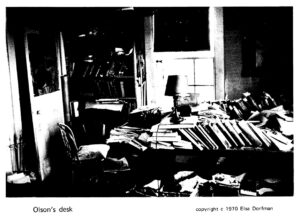The first issue of This (1971) included a short photo essay and memorial to Charles Olson by photographer Elsa Dorfman, who died in May 2020. Bob Grenier, co-editor and mentor, had moved to a small house by the cove in Lanesville, Mass., on Cape Ann, and would have been in contact with Robert Creeley, Larry Eigner, and, through poetry connections, Elsa Dorfman. Olson had recently died (10 January 1970) and I was in the thick of his influence, visiting Gloucester that summer and organizing a reading group on the “modern epic” at Iowa in the academic year 1971–72 that included renowned scholar Sherman Paul, who credited the group discussion in his book Olson’s Push (1978). A signal moment in that seminar was unfolding the Coast and Geodetic Survey map of Gloucester harbor, which I bought when I visited, to provide a “spatial reading” of the otherwise cryptic poem: “In the harbor // Can 9 Nun 8 / Nun 10 Can 11 //// Charles Olson / Friday, November 23rd // #1” (Maximus IV V VI, n.p.; Maximus Poems, 302). From the map, one can track a sequence of buoys in the harbor (termed “cans” and “nuns” from their shapes, presumably) that transposes the subject-centered experience of sighting the buoys to a sequence of signs in space. It is tempting to imagine that Language writing was born right there, though there were many converging influences, never reducible to a moment of origin. In fact, it was the gap between what Olson was seeing and what his poem and the map record that signified, a way of reading that makes clear why the poem had to be written as it was. Many of the short poems from the second volume of Maximus, along with Creeley’s Pieces, were objects of fascination then. … More
Entries tagged with Charles Olson
January 7, 2010
Entry 03: Mala cosa
This entry takes the place of a previous one, which turned out to be a gateway for malware. I wanted to undertake a small conceptual project, after posting Asa’s logo of Detroit “rising from the ashes,” of searching for the words “deterritorializing Detroit” and putting up the results, for use later perhaps. I did so, and listed the top ten entries, with descriptive copy: theory and techno, Arab Detroit and hiphop, globalization and Fordism were among the links.
The next morning I clicked on one, a theory blog that connected Deleuze and Guattari with Detroit techno. I checked a music site for Drexciya, a techno group from the 90s that has since disbanded—this was the entry point for the malware, which crashed the firewall and set up a fake virus protection program that simulated a virus scan, posted the results, and demanded payment as protection from further threats. Every action I took to bypass it resulted in an error message that said “program infected” or produced another popup.












